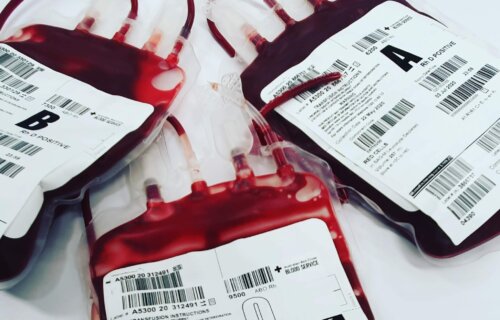BALTIMORE — Artificial blood may finally ease the desperate need for blood donations. Now, this life-saving product is one step closer to reality, thanks to a new federal funding. Researchers at the University of Maryland School of Medicine (UMSOM) are developing and testing the new, cutting-edge blood alternative. They say wounded soldiers on the battlefield could receive a transfusion using this blood within a half-hour of injury — potentially saving thousands of lives.
“We have assembled an outstanding team to develop a bio-synthetic whole-blood product that can be freeze-dried for easy portability, storage, and reconstitution,” says study principal investigator Allan Doctor, MD, Professor of Pediatrics and Director of the Center for Blood Oxygen Transport and Hemostasis (CBOTH) at UMSOM in a media release.
“It will be designed for easy use in the field by medics at the point of injury, and will perform like a traditional blood transfusion to, for example, stabilize a patient’s blood pressure or facilitate blood clotting.”
To create this new alternative to real blood, researchers plan to utilize artificial intelligence, state-of-the-art experimental platforms, and an array of animal models. They will test product efficacy and safety in trauma victims suffering from multiple complex injuries such as shock and traumatic brain injury.
Bleeding is the most common cause of death from possibly survivable trauma injuries among both military and civilian patients. While whole blood transfusions remain the gold standard for treatment, there are several limitations to its use like the availability of donors, cold storage requirements, and a limited shelf life (40 days). This is why many scientists are turning to artificial products as a possible solution. This program’s product would be storable at room temperature and have an extended shelf life.
What’s in artificial blood?
The product consists of ErythroMer, the artificial blood product made by a company called KaloCyte, co-founded by Dr. Doctor in 2016 in collaboration with bioengineer and synthetic chemist Dipanjan Pan, PhD, MSc, Professor of Pediatrics and Diagnostic Radiology Nuclear Medicine at UMSOM, and Philip Spinella, MD, a military transfusion medicine expert at Washington University. It will also consist of synthetic platelets produced by Anirban Sen Gupta, PhD of Case Western Reserve University — under development by Haima Therapeutics — as well as a freeze-dried plasma product made by a company called Telefex.
The plan is to start out by integrating several bio-artificial and synthetic components to deliver oxygen, stop bleeding, and replace volume, which are the main therapeutic functions of whole blood transfusions. Next, the team will test for efficacy and safety in realistic models, as well as generate ways to stabilize the product and make it last for months under extreme environmental conditions.
Throughout all of this, the team will also fine-tune manufacturing methods in order to address the real-world challenges of getting the product on the market, including production, scaling, packaging, and quality control. This four-year research project, led by UMSOM, received $46.4 million from the Defense Advanced Research Projects Agency (DARPA).

